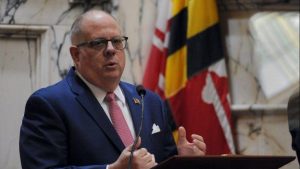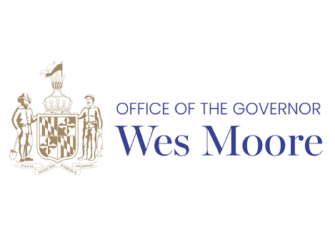
Commits New Resources to Crime Prevention, Prosecution, and Witness Protection; Expands Attorney General’s Office to Prosecute Violent Crime; Record Funding to Address Mental Health and Substance Use Disorder
Funds K-12 Education at Record Levels for Sixth Consecutive Year; Record Funding for School Construction; Record Funding for Community Colleges
Advances Critical Howard Street Tunnel Project to Break East Coast Bottleneck, Bring Thousands of Jobs to the Baltimore Region, Secure Future of the Port of Baltimore
Fully Funds Chesapeake Bay Restoration Efforts for Fifth Consecutive Year; Fully Funds Program Open Space and Land Preservation Programs
Structurally Balanced; Limits Budget Growth to 1 Percent Without Raising Taxes or Cutting Services; Maintains $1.3 Billion in Reserves; Keeps State’s AAA Bond Rating
ANNAPOLIS, MD—Governor Larry Hogan today announced highlights of his Fiscal Year 2021 (FY21) budget, which delivers on Marylanders’ top priorities by investing in initiatives to address violent crime, funding education at record levels for the sixth consecutive year, advancing the critical Howard Street Tunnel project to bring thousands of jobs to the Baltimore region, and fully funding Chesapeake Bay restoration efforts and land preservation programs.
This ‘Accountability Budget’ is 100% structurally balanced, limits budget growth to 1 percent without raising taxes or cutting services, and maintains more than $1.3 billion in reserves—above the legislature’s guidelines.
“Our FY 2021 budget reflects the most urgent priorities of Marylanders—crime, education, transportation, and the environment—while keeping the commitment I first made five years ago to bring fiscal restraint to Annapolis and to hold the line on unaffordable spending,” said Governor Hogan. “Last week, I stressed that the overall theme of this legislative session should be increasing accountability, and we are following through on that by submitting an ‘Accountability Budget.’”
Tomorrow morning, Governor Hogan will host a bipartisan breakfast to brief the state’s legislative and fiscal leaders prior to the budget’s formal release.
Highlights of Governor Hogan’s Accountability Budget
Violent Crime
“Just last Saturday, 12 people were shot and five people were killed in Baltimore,” said Governor Hogan. “The number one concern of Marylanders is crime. Citizens are demanding more accountability for the violent criminals who are shooting and killing people on the streets of Baltimore City.”
- In FY21, police aid to local governments is funded at $74.5 million and local law enforcement grants are funded at $38.7 million. Another $1.9 million is provided for the Violence Intervention and Prevention Program.
- In the second year of the Governor’s Baltimore City Crime Prevention Initiative, the FY21 budget includes $6.9 million for grants that support crime prevention, prosecution, and witness protection and $2.7 million for the Baltimore Regional Intelligence Center.
- In keeping with Governor Hogan’s commitment to address the violent crime crisis in Baltimore City, the FY21 budget includes nearly $2.6 million for 25 new prosecutors and support staff for the Attorney General to prosecute violent crime.
- The budget maintains $3 million to fund initiatives to recruit and retain police officers at the local level.
- The FY21 budget include nearly $272 million for community and residential operations to provide direct care services to youth under the Department of Juvenile Services’ supervision.
Record Education Funding
“Once again, our budget provides historically high record funding for K-12 education,” said Governor Hogan. “This is our sixth consecutive budget to do so.”
- The governor’s budget funds K-12 education at record levels for the sixth consecutive year—including $7.3 billion in FY21—and again goes above and beyond the legislature’s funding formulas to ensure that every jurisdiction receives more funding than in the prior year.
- The governor’s capital budget includes record funding for school construction—a total of $733 million—as part of an initiative to invest nearly $3.9 billion in school construction over the next five years. More than 75 percent of the governor’s capital budget goes toward education.
- The governor’s budget includes more than $350 million for initiatives consistent with the Kirwan Commission’s recommendations, including $65.5 million for special education grants, $64 million for pre-kindergarten supplemental grants, $65.2 million for expanded community schools with enhanced services for free and reduced-price meal (FARM) eligible students, and $45.6 million for expansion of early childhood initiatives.
- The governor’s budget includes nearly $94 million to support the expansion of pre-kindergarten. Under the Hogan administration, state funding to expand access to pre-kindergarten education has grown by more than 2,000 percent.
- The governor’s budget includes record funding for community colleges. Cade funding in FY21 for community colleges increases by $18.2 million or 7.3 percent. Since Governor Hogan took office, funding per student at community colleges has grown by 50 percent.
- The governor’s budget again caps in-state resident tuition growth at 2 percent for the University System of Maryland, Morgan State University, and St. Mary’s College of Maryland.
Howard Street Tunnel
“For years, we have been working to move the transformative Howard Street Tunnel project forward,” said Governor Hogan. “With the investment of $80 million in this budget, we will finally be able to move forward on this project. This will be one of the biggest economic development job-creating projects in state history.”
- The governor’s budget funds the critical Howard Street Tunnel project to increase business at the Port of Baltimore and bring thousands of jobs to the region. An investment of $80.3 million in FY21 in the $466 million project includes resources from the state, a federal infrastructure grant, and a partnership with CSX.
- According to economic impact studies, the project will create 6,550 person-year jobs during the construction phase and 7,290 permanent Maryland jobs, which are in turn linked to more than 60,000 jobs that are supported among port users in the Baltimore region.
- As a result of the project, the new container activity at the marine terminal would generate more than $1 billion in personal and business revenues in Maryland annually.
- “By any measure,” The Baltimore Sun editorial board wrote, “this deserves to be at the very top of the Baltimore region’s economic development wish list.”
Skilled Environmental Stewardship
“When it comes to the environment, we are once again fully funding bay restoration efforts for the fifth straight year, including record funding—$57.2 million dollars—for the Chesapeake and Atlantic Coastal Bays Trust Fund, which is nearly a 7 percent increase over last year,” said Governor Hogan.
- The governor’s budget fully funds Chesapeake Bay restoration efforts for the fifth straight year, including record funding of $57.2 million for the Chesapeake and Atlantic Coastal Bays 2010 Trust Fund.
- The governor’s capital budget includes more than $280 million for projects to protect the Chesapeake Bay and the quality of water for Marylanders statewide.
- The governor’s budget fully funds Program Open Space and land conservation programs. The FY21 budget also includes $43.9 million to continue the repayments of past transfers.
- The governor’s budget provides additional funding and positions to support agricultural conservation practices to help Maryland farmers implement the Phosphorus Management Tool and meet Phase III Watershed Implementation Plan goals.
Fiscal Accountability
“This budget funds all of the state’s top priorities, while maintaining $1.3 billions in reserves, and limiting budget growth to 1 percent, without raising taxes, without cutting services, and without raiding dedicated special funds, which had become a common practice in years past,” said Governor Hogan.
- For the sixth consecutive year, the governor’s budget is structurally balanced. It also limits spending growth to 1.0 percent, without raising taxes, cutting services, or raiding dedicated special funds.
- The governor’s budget exceeds the legislature’s guidelines by leaving a Rainy Day Fund balance of 6.25 percent of revenues, $242 million more than the statutory requirement, and a cash surplus greater than $100 million.
- When combining the FY21 ending fund balance and the funds available in the Rainy Day Fund, the state has more than $1.3 billion in reserves.


